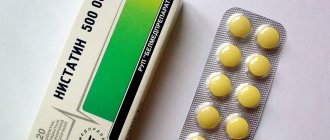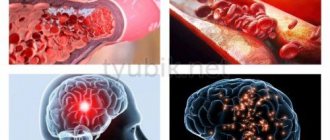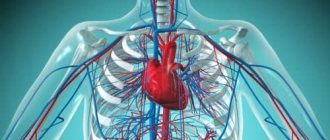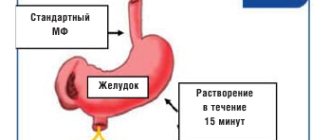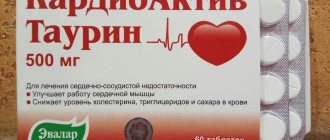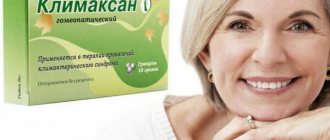Pharmacological properties
Pharmacodynamics
Itraconazole is a synthetic broad-spectrum antifungal agent, a triazole derivative.
Inhibits the synthesis of ergosterol in the cell membrane of fungi, which determines the antifungal effect of the drug. Itraconazole is active against infections caused by dermatophytes (Trichophyton spp., Microsporum spp., Epydermophyton floccosum), yeast-like fungi and yeasts (Cryptococcus neoformans, Pityrosporum spp., Candida spp., including C.albicans, C.glabrata and C.krusei), Aspergillus spp., Histoplasma spp., Histoplasma spp., Paracoccidioides brasiliensis, Sporthrix schenckii, Fonsecaea spp., Cladosporium spp., Blastomyces dermatitidis, as well as other yeasts and molds. Pharmacokinetics
Absorbed from the gastrointestinal tract quite completely. Taking itraconazole capsules immediately after meals increases bioavailability. Cmax in plasma is achieved within 3-4 hours after oral administration. Css when taking 100 mg of the drug once a day - 0.4 mcg/ml; when taking 200 mg 1 time per day - 1.1 mcg/ml, 200 mg 2 times a day - 2 mcg/ml.
The time for the onset of Css in plasma with long-term use is 1-2 weeks. Bonding with plasma proteins is 99.8%.
Penetrates well into tissues and organs (including the vaginal mucosa), and is contained in the secretion of the sebaceous and sweat glands. The concentration of itraconazole in the lungs, kidneys, liver, bones, stomach, spleen, and skeletal muscles is 2-3 times higher than its concentration in plasma; in tissues containing keratin - 4 times.
The therapeutic concentration of itraconazole in the skin remains for 2-4 weeks after cessation of the 4-week course of treatment. The therapeutic concentration in nail keratin is achieved 1 week after the start of treatment and remains for 6 months after completion of the 3-month course of treatment. Low concentrations are detected in the sebaceous and sweat glands of the skin.
Metabolized in the liver to form active metabolites, incl. hydroxyitraconazole. It is an inhibitor of the isoenzymes CYP3A4, CYP3A5 and CYP3A7.
Excretion from plasma is two-phase: by the kidneys within 1 week (35% in the form of metabolites, 0.03% unchanged) and through the intestines (3-18% unchanged). T1/2 - 1-1.5 days. It is not removed during dialysis.
Itraconazole for thrush
Representatives of the fair sex know firsthand about thrush, what can we say if there are those among men who have encountered this disease. Interestingly, the causative agents of this disease are the natural inhabitants of our microflora - yeast-like fungi. Why do they start acting aggressively?
There can be a lot of factors that can lead to the appearance of candidiasis: wearing synthetic underwear, constant hypothermia, failure to maintain proper intimate hygiene, hormonal imbalances, endocrine disorders, uncontrolled use of antibiotics - these are not all the reasons that lead to the development of the disease.
You should not delay treatment, as this can lead to serious complications, even including infertility. The unpleasant symptoms of the disease will only intensify, causing enormous discomfort:
- burning of the genitals;
- itching;
- swelling and redness;
- white discharge;
- pain when urinating;
- pain during sexual intercourse.
The pharmaceutical industry offers a wide range of medicines. Patients often rely on commercials and reviews from friends when choosing a drug, but this is wrong. What worked for your friend won't necessarily work for you, and a well-known product can be a good publicity stunt.
The prescription of a course of treatment by a doctor is what you need to rely on. Doctors have the necessary knowledge base to help them make the right decision. Itraconazole for thrush is a well-known remedy that has proven itself to be the best. Why has the product earned accolades?
Indications for use
- dermatomycosis;
- fungal keratitis;
- onychomycosis caused by dermatophytes and/or yeasts and molds;
- systemic mycoses: systemic aspergillosis and candidiasis, cryptococcosis (including cryptococcal meningitis), histoplasmosis, sporotrichosis, paracoccidioidomycosis, blastomycosis and other systemic or tropical mycoses.
- candidomycosis with damage to the skin or mucous membranes, including vulvovaginal candidiasis;
- deep visceral candidiasis;
- pityriasis versicolor.
Treatment regimen for chronic thrush with itraconazole
Treatment should be carried out under the supervision of a doctor and includes several stages:
- combating provoking factors, which includes maintaining intimate hygiene, strengthening the immune system, wearing natural underwear, etc.;
- proper nutrition, which includes limiting carbohydrates and sweets;
- rejection of bad habits;
- drug therapy.
For thrush, the daily dosage is two hundred milligrams. Treatment is carried out throughout the week. The duration and dosage may be changed by the doctor depending on the severity of the pathological process. Capsules are taken after meals.
Directions for use and doses
Inside, after eating.
| Indications | Dose | Duration |
| Vulvovaginal candidiasis | 200 mg 2 times a day or 200 mg 1 time a day | 1 day 3 days |
| Pityriasis versicolor | 200 mg 1 time per day | 7 days 15 days |
| Dermatomycosis of smooth skin | 200 mg once a day 100 mg once a day | 7 days 15 days |
| Lesions of highly keratinized areas of the skin, such as the hands and feet | 200 mg 2 times a day or 100 mg 1 time a day | 7 days 30 days |
| Candidiasis of the oral mucosa | 100 mg 1 time per day | 15 days |
| Fungal keratitis | 200 mg 1 time per day | 21 day |
The oral bioavailability of itraconazole may be reduced in some immunocompromised patients, such as neutropenic patients, patients with AIDS, or organ transplant recipients. Therefore, a doubling of the dose may be required.
Onychomycosis
Pulse therapy (see table) One course of pulse therapy consists of taking 2 capsules of ITRAZOL® twice a day (200 mg twice a day) daily for one week. For the treatment of fungal infections of the nail plates of the hands, two courses are recommended. For the treatment of fungal infections of the nail plates of the feet, three courses are recommended (see table). The interval between courses during which you do not need to take the drug is 3 weeks. Clinical results will become obvious after the end of treatment, as the nails grow back.
| Localization of onychomycosis | 1st week | 2nd, 3rd, 4th weeks | 5th week | 6th, 7th, 8th weeks | 9th week |
| Damage to the nail plates of the feet with or without lesions to the nail plates of the hands | 1st year | Weeks free from taking Itrazole | 2nd year | Weeks free from taking Itrazole | 3rd year |
| Damage to the nail plates of the hands | 1st year | Weeks free from taking Itrazole | 2nd year | Weeks free from taking Itrazole | 3rd year |
OR Continuous treatment:
Two capsules per day (200 mg once daily) for 3 months.
The elimination of ITRAZOL® from the skin and nail tissue is slower than from plasma. Thus, optimal clinical and mycological effects are achieved 2-4 weeks after the end of treatment for skin infections and 6-9 months after the end of treatment for nail infections. Systemic mycoses
(recommended dosages vary depending on the type of infection)
| Indication | Dose | Average duration | Notes |
| Aspergillosis | 200 mg 1 time per day | 2-5 months | In case of invasive or disseminated disease, it is recommended to increase the dose to 200 mg 2 times a day |
| Candidiasis | 100-200 mg 1 time per day | From 3 weeks to 7 months | In case of invasive or disseminated disease, it is recommended to increase the dose to 200 mg 2 times a day |
| Cryptococcosis (except meningitis) Cryptococcal meningitis | 200 mg once daily 200 mg twice daily | From 2 months to 1 year | Maintenance therapy (cases of meningitis) |
| Histoplasmosis Sporotrichosis Paracoccidioidomycosis Chromomycosis Blastomycosis | 200 mg once daily to 200 mg twice daily 100 mg once daily 100 mg once daily 100-200 mg once daily from 100 mg once daily to 200 mg twice daily | 8 months 3 months 6 months 6 months 6 months |
Application in pediatrics.
It is recommended to use Itrazol® in children over 3 years of age only if the possible benefit outweighs the potential risk.
Drug interactions
The drug is not compatible with alcohol intake
The list of drug interactions is very long. More details can be found in the official instructions for use of the drug. Before using the drug Itrazol, you must consult your doctor, telling him in detail about all the medications that the patient takes constantly or occasionally.
Drugs that reduce the concentration of Itrazole in the blood plasma and slow down its metabolism:
- antiepileptic drugs (including phenobarbital, carbamazepine),
- drugs for tuberculosis,
- antacids,
- Nevirapine.
When taking the drug Itrazol simultaneously with the listed medications, you should take into account the likelihood of a deterioration in the therapeutic effect of the antifungal drug. In this regard, it may be necessary to increase the duration of medication or adjust the dosage.
Itrazol tablets worsen the effect of the following drugs:
- Carbamazepine,
- antiarrhythmic drugs,
- Rifabutin,
- benzodiazepines,
- Verapamil and other calcium channel blockers,
- antipsychotic Pimozide,
- Cisapride,
- immunosuppressants.
When taking the listed drugs with Itrazol, it is necessary to adjust their dosage. The effect of the drug increases when taking macrolides, which can lead to increased toxicity of anti-fungal tablets.
Itrazole and alcohol are incompatible. Despite the low hepatotoxicity of the drug against fungus, ethanol increases the risk of developing dangerous complications for the liver. This is especially true for patients suffering from impaired liver function and patients with cirrhosis and liver failure.
Any alcohol increases the effect of Itrazol tablets, so alcohol is prohibited while taking the medication.
Patients with diabetes mellitus should be careful, since Itrazole has a negative effect on metabolism and, when taken simultaneously with glucose-lowering tablets, there is a risk of developing hypoglycemia.
Side effects
From the gastrointestinal tract:
dyspepsia, nausea, abdominal pain and constipation, reversible increase in liver enzyme activity, cholestatic jaundice, hepatitis, anorexia. In very rare cases, when using Itrazol®, severe toxic damage to the liver developed, incl. case of acute liver failure with fatal outcome
From the side of the central nervous system:
headache, fatigue, dizziness, peripheral neuropathy.
From the SSS side:
congestive heart failure and pulmonary edema.
From other organs and systems:
menstrual irregularities, allergic reactions (such as itching, rash, urticaria and angioedema), Stevens-Johnson syndrome, alopecia, hypokalemia, edema, dark urine, hypercreatininemia.
What to choose: fluconazole or itraconazole?
Speaking about the differences, first of all I would like to mention the pricing policy, fluconazole costs between 35-50 rubles, and itraconazole 400-450 rubles, as you can see, the difference is obvious.
Just like itraconazole, fluconazole has a broad spectrum of action and has fungicidal properties. It should not be used during pregnancy and lactation. Fluconazole rarely causes side effects, but sometimes problems with the digestive system may occur.
If for acute thrush it is enough to take a fluconazole capsule once, then treatment with itraconazole will require more time. For chronic thrush, fluconazole should be taken once every three days for three doses, and itraconazole once a day for a week.
Which is better: fluconazole or itraconazole? Perhaps this should be decided by a doctor in your specific situation. It is better to trust professionals in this situation.
So, does itraconazole help with thrush? Undoubtedly, this is an effective remedy in the fight against candidiasis. The product has some limitations, so it should be used under the supervision of a doctor.
Literature
- Kisina V.I. and others. Gynecology. 2000. No. 2 (6). pp. 193–197.
- Mishina G.M. Gynecology. 2001. No. 6 (3). pp. 208–218.
- Kungurov N.V., Gerasimova N.M. and others. Urogenital candidiasis. Educational and methodological manual. Ekaterinburg, 2002. pp. 3–4.
- Kubanova A.A., Potekaev N.S., Potekaev N.N. Guide to practical mycology. M., 2001. P. 143.
- Kashkin P.M., Sheklakov N.D. Manual of medical mycology. M.: Medicine, 1978. P. 137.
- Adaskevich V.P. Sexually transmitted infections. N. Novgorod: NGMA Publishing House; M.: Medical book, 2002. pp. 232–234.
- Prilepskaya V.N., Ankirskaya A.S., Bayramova G.R., Muravyova V.V. Vaginal candidiasis. M. 1997. P. 40.
- Antonev A.A., Bulwakhter L.A., Glazkova L.K., Ilyin I.I. Candidiasis of the skin and mucous membranes. M.: Medicine, 1985. P.160.
- Sergeev A. Yu., Sergeev Yu. V. Candidiasis. M.: Triada, 2000. P. 156.
- Heykants J., Van Peer A., Van de Velde V. et al. The clinical pharmacokinetics of itraconazole: an overview // Mycoses. 1989. Vol. 32(Suppl. 1). P. 67–87.
- Rees T., Philips R. Multicenter comparison of one-day oral therapy with fluconazole or itraconazole in vaginal candidiasis // Int. J. Gynecol. Obstet. 1992. Vol. 37(Suppl). P. 33–38.
- Fong IW The value of chronic suppressive therapy with itraconazole versus clotrimazole in women with recurrent vaginal candidiasis // Genitourin. Med. 1992. Vol. 68(6). P. 374–377.
Pimafucin
This cream is a very effective treatment for thrush in men and is an antibiotic that has a fungicidal effect.
The product acts on the membranes of harmful elements, destroying them, disrupting the integrity of cells and thereby causing their rapid death.
The drug is often prescribed for the treatment of other ailments caused by fungi, and not just for the treatment of thrush in men, however, it should not be used independently.
The duration of use of the substance, as well as the need for it, can only be determined by a doctor who will monitor the progress of treatment. The tablet form of the drug can be prescribed only for a protracted type of disease and its complications, simultaneously with the cream as a complex therapy.
Prevention of nail fungus
The main prevention against any fungal disease is compliance with the rules of personal hygiene, prevention of various injuries and damage to the feet. In addition, it is important to promptly treat excessive sweating of the feet or dry skin, as well as promptly take measures for any degenerative changes in the nail plate.
When visiting public places, you must wear individual rubber slippers. In stores you need to purchase only high-quality shoes made from natural materials, and when trying them on, use an individual footwear.
Prevention of onychomycosis includes disinfection and anti-epidemic measures, as well as sanitary and educational work. If any dystrophic changes in the nails appear, it is necessary to seek medical help and undergo timely treatment.
Triderm
It is a combined preparation for external use against thrush, combining Clotrimazole, Gentamicin and Betamethasone dipropionate, due to which it simultaneously has anti-inflammatory, antibacterial, antipruritic, antiexudative and antiallergic effects.
Independent use of such a drug, as well as its unreasonable use, can cause serious harm to the patient, since the drug is prescribed in cases of various severe skin diseases.
To treat thrush, the product can only be used on the recommendation of a doctor with a precise indication of the dosage and application schedule, but only when it is really necessary.
Tetraborate
The bacteriostatic activity of this drug is very high, but the drug cannot be called an antifungal, used in the treatment of men for candidiasis.
Applying this ointment to the genitals and other affected areas creates a serious obstacle to the attachment of fungal cells to the mucous membranes, which significantly reduces their further reproduction and development of the disease.
The product should be used only as prescribed by a doctor and only as part of a general complex therapy aimed at destroying fungal flora, restoring the immune system and eliminating the underlying disease.
Contraindications
It is advisable to prescribe Itrazole for the following pathological conditions:
- Fungal infection, the development of which was influenced by yeast-like fungi or dermatophytes.
- Skin diseases and pathologies of the mucous membranes - lichen, oral thrush (more details here), vulvovaginal thrush, fungal infection of the upper layers of the eye.
- Fungal infections that are caused by pathogenic microflora that are sensitive to intraconazole.
- Common mycoses are cryptococcosis (caused by the fungi Cryptococcus neoformans), aspirgellosis (caused by Aspergillus fungi), cryptococcal meningitis.
There are a number of contraindications in which Itrazol cannot be used against fungus:
- Combined use with medications, the components of which are broken down by the CYP3A4 isoenzyme.
- Children under 3 years old.
- During pregnancy and breastfeeding.
- Lack of sucrase, intolerance to fructose, impaired absorption of monosaccharides in the gastrointestinal tract.
- Increased individual sensitivity to additional components of the drug.
Flucostat
An effective antifungal drug based on Fluconazole. The product is characterized by rapid dissolution in the digestive system, rapid accumulation in affected tissues, as well as in natural biological fluids, which greatly increases the effect of the therapy.
Only a doctor should prescribe the drug after a full examination and an accurate diagnosis. You should not do this on your own, even on the advice of friends or relatives whom he helped.
As a rule, with the usual form of thrush, a single dose of 150 mg is required, but with an advanced or chronic form, the course of treatment will be individual and can take from two weeks to a year.
Analogs
Analogs (generics) are drugs that have the same composition and therapeutic effect, but are produced by different manufacturers. Often the reason for prescribing a generic drug is its low price compared to its analogue. For Itrazol, there are the following analogues:
- itraconazole;
- isol;
- Iconazole;
- itracon;
- itral;
- itrasin;
- itrungar;
- irunin;
- metrics;
- mykokur;
- mycostop;
- orungal;
- orungamine;
- orunzol;
- sporagal;
- sporaxol;
- trioxal;
- funit;
- eszol.
Itraconazole Itral
Itrungar Irunin
Mycostop Orungal Orungamin
Sporagal Sporaxol
Funit Eszol
